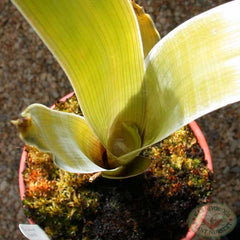
Bromeliads
Carnivorous Bromeliads
Some folks are surprised that there are some bromeliads that are carnivorous. In fact there are several including: Brocchina reducta, B. tatei, and Catopsis berteroniana. To be carnivorous, a plant must lure, capture and digest its prey. In the case of these bromeliads, they work in a manner similar to Sarracenia or other pitcher plants, with the hollows of the leaf clusters acting like a pitfall trap with slippery, waxy leaves. Earlier it was believed that they do not secrete digestive enzymes, and that bacterial decomposition was the digestive process. However in 2006, B. J. Plachno proved that B. reducta does secrete digestive enzymes and absorbs the nutrients.
The carnivorous bromeliads are members of the Pineapple Family. They are exclusively of the New World, particularly the Caribbean and the Guiana Highlands. They have very long strap like leaves that are closely compacted into a whorl or tubular barrel, which often collect and hold water. The leaves are waxy and often have pretty colors and patterns, fine red stripes in the case of B. reducta.
Carnivorous Bromeliads are typically propagated from divisions of "pups" or small plants emerging from the roots. They are also cloned in tissue culture. Seeds are rare in cultivation.




